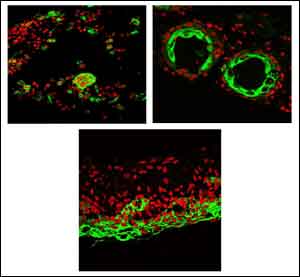- Home
- Editorial
- News
- Practice Guidelines
- Anesthesiology Guidelines
- Cancer Guidelines
- Cardiac Sciences Guidelines
- Critical Care Guidelines
- Dentistry Guidelines
- Dermatology Guidelines
- Diabetes and Endo Guidelines
- Diagnostics Guidelines
- ENT Guidelines
- Featured Practice Guidelines
- Gastroenterology Guidelines
- Geriatrics Guidelines
- Medicine Guidelines
- Nephrology Guidelines
- Neurosciences Guidelines
- Obs and Gynae Guidelines
- Ophthalmology Guidelines
- Orthopaedics Guidelines
- Paediatrics Guidelines
- Psychiatry Guidelines
- Pulmonology Guidelines
- Radiology Guidelines
- Surgery Guidelines
- Urology Guidelines
USC Stem Cell scientists obtain how to guide for producing hair follicles

How does the skin develop follicles and eventually sprout hair? A USC-led study, published in the Proceedings of the National Academy of Sciences (PNAS), addresses this question using insights gleaned from organoids, 3D assemblies of cells possessing rudimentary skin structure and function including the ability to grow hair.
In the study, first author Mingxing Lei, a postdoctoral scholar in the USC Stem Cell laboratory of Cheng-Ming Chuong, and an international team of scientists started with dissociated skin cells from a newborn mouse. Lei then took hundreds of time lapse movies to analyze the collective cell behavior. They observed that these cells formed organoids by transitioning through six distinct phases: 1) dissociated cells; 2) aggregated cells; 3) cysts; 4) coalesced cysts; 5) layered skin; and 6) skin with follicles, which robustly produce hair after being transplanted onto the back of a host mouse.
In contrast, dissociated skin cells from an adult mouse only reached phase 2--aggregation--before stalling in their development and failing to produce hair.
To understand the forces at play, the scientists analyzed the molecular events and physical processes that drove successful organoid formation with newborn mouse cells.
"We used a combination of bioinformatics and molecular screenings, and the core facilities at the Health Sciences Campus have facilitated my analyses," said Lei.
At various time points, they observed increased activity in genes related to: the protein collagen; the blood sugar-regulating hormone insulin; the formation of cellular sheets; the adhesion, death or differentiation of cells; and many other processes. In addition to determining which genes were active and when, the scientists also determined where in the organoid this activity took place. Next, they blocked the activity of specific genes to confirm their roles in organoid development.
By carefully studying these developmental processes, the scientists obtained a molecular "how to" guide for driving individual skin cells to self-organize into organoids that can produce hair. They then applied this "how to" guide to the stalled organoids derived from adult mouse skin cells. By providing the right molecular and genetic cues in the proper sequence, they were able to stimulate these adult organoids to continue their development and eventually produce hair. In fact, the adult organoids produced 40 percent as much hair as the newborn organoids--a significant improvement.
"Normally, many aging individuals do not grow hair well, because adult cells gradually lose their regenerative ability," said Chuong, senior author, USC Stem Cell principal investigator and professor of pathology at the Keck School of Medicine of USC. "With our new findings, we are able to make adult mouse cells produce hair again. In the future, this work can inspire a strategy for stimulating hair growth in patients with conditions ranging from alopecia to baldness."

Disclaimer: This site is primarily intended for healthcare professionals. Any content/information on this website does not replace the advice of medical and/or health professionals and should not be construed as medical/diagnostic advice/endorsement or prescription. Use of this site is subject to our terms of use, privacy policy, advertisement policy. © 2020 Minerva Medical Treatment Pvt Ltd